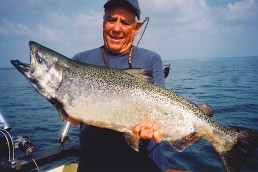Lake Michigan’s Chinook Salmon: How Wild are They?
SHARE THIS POST
In 1965, airline pilots approaching O’Hare Airport from the east could look down on Lake Michigan and clearly see the huge schools of alewives that dominated the fishery. At that time, the alewife was an invasive species that entered the Great Lakes via the St. Lawrence Seaway in the 1940s and constituted over 95 percent, by weight, of the lake’s biomass.
Each spring, following the little fish’s spawn period, dead alewives were piled so thickly on the beaches that they had to be removed by bulldozers. Cities and towns around the lake saw tourism decline and cleanup expenditures soar. With no answer in sight, everyone just threw up their hands and held their noses.
Well, almost everyone.
Over in Michigan, a bright fishery biologist named Dr. Howard Tanner was serving as head of the state’s DNR Division of Fisheries and began looking for ways to turn the alewife infestation into an opportunity. In 1966, after research, Dr. Tanner authorized the initial release of Pacific coho salmon into Lake Michigan. The cohos not only grew and prospered, they led the way to a world-class sport fishery that revitalized lakeside economies and brought the alewife population under control.
One of the most convincing arguments against the experimental coho stocking was that the lake lacked suitable salmon spawning habitat. If it were discovered the salmon additions were a mistake, they could be eliminated by the simple biological control of discontinuing the stocking.
When the cohos became an immediate sensation, Dr. Tanner quickly moved on an introduction of the larger chinook salmon. Like the cohos, the voracious chinooks took to the lake like a “fish takes to water” and began gobbling up prodigious quantities of alewives to the delight of all.
In 1990, the Eastern European zebra mussel, followed by the larger quagga mussel, found its way into the Great Lakes. These filter-feeding critters soon covered the lake’s bottom and were gorging on the same microorganisms the alewives depended on. It was predicted that the alewife population would suffer a significant decline as a result of this competition for food.
Are you enjoying this post?
You can be among the first to get the latest info on where to go, what to use and how to use it!
And it did.
Then the entire fishery began to weaken as yellow perch schools shrunk and the growth rates of the major predators slowed. Since the mussels could not be brought under any kind of control, the only option available to the fishery managers was to reduce chinook stocking in an effort to take some pressure off the baitfish and play the “biological control” card. At about the same time, the chinooks began spawning successfully in some of Michigan’s larger rivers. Salmon spawn in the fall, and because young cohos remain in their natal streams for 16 months, they all die when the Midwestern rivers heat up in summer. But chinook smolts survive because they migrate into the lake in early spring, before the rivers warm up. The result is a subsequent huge, gratuitous “stocking” of wild chinook salmon, which is estimated to equal the amount of hatchery-raised fish that are planted. And, all of these eating machines feed exclusively on alewives.
The fishery managers recently moved to reduce the pressure on the quickly succumbing alewives by drastically cutting back on stocking hatchery-raised chinooks. Not surprisingly, charter boat operators and the businessmen around the lake who depend on the tourism dollars the big fish attract, disagreed and the fur began to fly.
While that battle is still being fought, let’s take a look at just how large a part the wild chinooks play in today’s Lake Michigan fishery.
The Salmon Ambassadors program is a Michigan Sea Grant initiative developed in coordination with the Michigan, Wisconsin, Illinois and Indiana DNRs and the U.S. Fish & Wildlife Service. In 2016, 201 volunteer charter captains and avid sport anglers submitted detailed reports on their chinook catches throughout the entire season to determine what percentage of their catch was composed of wild and hatchery-raised fish. Additionally, the fish were carefully weighed and measured to determine their physical condition. Positive identification of the wild chinook is possible because all planted chinooks have a fin clipped before their release.
The following is in northern Michigan and around to the Upper Wisconsin region, showing the percent of wild chinook fish caught in each area of the lake:
- Manistee, Mich., 83 percent
- Ludington, Mich., 86 percent
- Grand Haven south to Indiana state line, 68 percent
- All Indiana and Illinois waters, 70 percent
- Illinois state line to Sheboygan, 60 percent
- Kewaunee, Wis. to Door Peninsula tip, 59 percent
So, there it is. Far more wild chinooks are being caught than planted salmon, an ominous indication of how far out of control the population of this top-of-the-line predator has become. Add to this information the fact that lake trout are now naturally reproducing at faster and faster rates and are far more abundant than the available forage base can accommodate, and many have to wonder what should be done next.
MWO
SHARE THIS POST
Did you enjoy this post?
You can be among the first to get the latest info on where to go, what to use and how to use it!
Jerry Pabst
Jerry Pabst has been writing about the outdoors for over 40 years. He captained a Lake Michigan charter boat for 25 years and was inducted into the Fresh Water Fishing Hall of Fame. He has hunted waterfowl in all North American flyways, pursued upland game extensively, and trains his own dogs.



